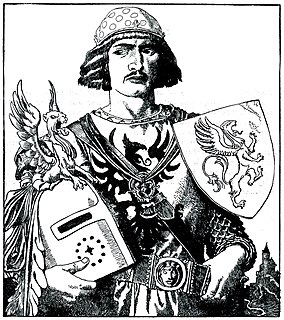
Gawain, also known as Gawaine or Gauwaine, among various other forms and spellings, is King Arthur's nephew and a Knight of the Round Table in the Arthurian legend. Under the name Gwalchmei, he is introduced very early in the legend's literature, being mentioned in some of the earliest Welsh Arthurian sources. As Gawain and related variants, he appears in Latin, French, English, Dutch, German, Spanish and Italian texts, notably as the protagonist of the story of Sir Gawain and the Green Knight. Other tales of Gawain include Historia Regum Britanniae, Roman de Brut, De Ortu Waluuanii, Diu Crône, The Awntyrs off Arthure, Ywain and Gawain, Golagros and Gawane, L'âtre périlleux, Le Chevalier à l'épée, and The Wedding of Sir Gawain and Dame Ragnelle, as well as the works of Chrétien de Troyes and the prose cycle Lancelot-Grail.

Lancelot du Lac, also written as Launcelot and other variants, is a character in some versions of Arthurian legend, where he is typically depicted as King Arthur's close companion and one of the greatest Knights of the Round Table. In the French-inspired Arthurian chivalric romance tradition, Lancelot is the orphaned son of King Ban of the lost kingdom of Benwick, raised in the fairy realm by the Lady of the Lake. A hero of many battles, quests and tournaments, and famed as a nearly unrivalled swordsman and jouster, Lancelot becomes the lord of Joyous Gard and personal champion of Arthur's wife Queen Guinevere. But when his adulterous affair with Guinevere is discovered, it causes a civil war that is exploited by Mordred to end Arthur's kingdom.

Mordred or Modred is a character who is variously portrayed in the Arthurian legend. The earliest known mention of a possibly historical Medraut is in the Welsh chronicle Annales Cambriae, wherein he and Arthur are ambiguously associated with the Battle of Camlann in a brief entry for the year 537. His figure seemed to have been regarded positively in the early Welsh tradition and may have been related to that of Arthur's son.

Sir Galahad among other versions of his name, is a knight of King Arthur's Round Table and one of the three achievers of the Holy Grail in Arthurian legend. He is the illegitimate son of Sir Lancelot and Elaine of Corbenic, and is renowned for his gallantry and purity as the most perfect of all knights. Emerging quite late in the medieval Arthurian tradition, Sir Galahad first appears in the Lancelot–Grail cycle, and his story is taken up in later works such as the Post-Vulgate Cycle and Sir Thomas Malory's Le Morte d'Arthur. His name should not be mistaken with Galehaut, a different knight from Arthurian legend.

The Lady of the Lake is a name or a title used by several fairy-like enchantresses in the Matter of Britain, the body of medieval literature and mythology associated with the legend of King Arthur. They play pivotal roles in many stories, including providing Arthur with the sword Excalibur, eliminating Merlin, raising Lancelot after the death of his father, and helping to take the dying Arthur to Avalon. Different sorceresses known as the Lady of the Lake appear concurrently as separate characters in some versions of the legend since at least the Post-Vulgate Cycle and consequently the seminal Le Morte d'Arthur, with the latter describing them as a hierarchical group, while some texts also give this title to either Morgan or her sister.

The Knights of the Round Table are the knights in the fellowship of King Arthur in the literary cycle of the Matter of Britain, first appearing in literature in the mid 12th century. In this French-derived branch of Arthurian legend, the Knights are an order dedicated to ensuring the peace of Arthur's kingdom following the period of early wars and later undergoing the mystical quest for the Holy Grail. The Round Table at which they meet is a symbol of the equality of all of its members, from sovereign royals to minor nobles.

Sir Gareth is a Knight of the Round Table in Arthurian legend. He was the youngest son of King Lot and Morgause, King Arthur's half-sister, thus making him Arthur's nephew, as well as brother to Gawain, Agravain, and Gaheris, and either a brother or half-brother of Mordred. He is particularly notable in Le Morte d'Arthur where he is also known by his nickname Beaumains.
Elaine is a name shared by several different female characters in Arthurian legend.

In Arthurian legend, the Fisher King, also known as the Wounded King or Maimed King, is the last in a long bloodline charged with keeping the Holy Grail. Versions of the original story vary widely, but he is always wounded in the legs or groin and incapable of standing. All he is able to do is fish in a small boat on the river near his castle, Corbenic, and wait for some noble who might be able to heal him by asking a certain question. In later versions, knights travel from many lands to try to heal the Fisher King, but only the chosen can accomplish the feat. This is achieved by Percival alone in the earlier stories; he is joined by Galahad and Bors in the later ones.
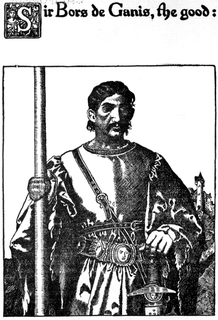
Bors is the name of two knights in Arthurian legend, an elder and a younger. The two first appear in the 13th-century Lancelot-Grail romance prose cycle. Bors the Elder is the King of Gaunnes (Gannes/Gaunes/Ganis) during the early period of King Arthur's reign, and is the brother of King Ban of Benoic and the father of Bors the Younger and Lionel. His son Bors the Younger later becomes one of the best Knights of the Round Table and participates in the achievement of the Holy Grail.
Ban is the King of Benwick or Benoic in Arthurian legend. First appearing by this name in the Lancelot propre part of the Vulgate Cycle, he is the father of Sir Lancelot and Sir Hector de Maris, and is the brother of King Bors. Ban largely corresponds to the other versions of the father of Lancelot, including Pant of Gen[n]ewis in Lanzelet, Haud of Schuwake in the English Lancelot, and Domorot of Lokva in Provest o Tryschane.

Gaheris or Gaheries is a character in the Arthurian legend, a nephew of King Arthur and a knight of the Round Table, the third son of Arthur's sister or half-sister Morgause and her husband Lot, King of Orkney and Lothian. He is the younger brother of Gawain and Agravain, and the older brother of Gareth and half-brother of Mordred. In Thomas Malory's popular Le Morte d'Arthur, Gaheris is little more than a supporting character to Gawain and Gareth, with the murder of Morgause an odd exception, but his role is greater in the French prose cycles. Later, he and Gareth are both killed by Lancelot during his rescue of Guinevere. A different knight known as Gaheris of Karaheu also appears in the legend.

Sir Agravain is a Knight of the Round Table in Arthurian legend, whose first known appearance is in the works of Chrétien de Troyes. He is the second eldest son of King Lot of Orkney with one of King Arthur's sisters known as Anna or Morgause, thus nephew of King Arthur, and brother to Sir Gawain, Gaheris, and Gareth, as well as half-brother to Mordred. Agravain secretly makes attempts on the life of his hated brother Gaheris since the Vulgate Cycle, participates in the slayings of Lamorak and Palamedes in the Post-Vulgate Cycle, and murders Dinadan in the Prose Tristan. In the French prose cycle tradition included in Thomas Malory's Le Morte d'Arthur, together with Mordred, he then plays a leading role by exposing his aunt Guinevere's affair with Lancelot, which leads to his death at the hands of Lancelot.
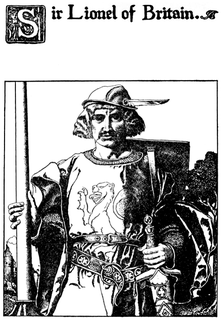
Sir Lionel is the younger son of King Bors of Gaunnes and Evaine and brother of Bors the Younger in Arthurian legend since the Lancelot-Grail cycle. He is a double cousin of Lancelot and cousin of Lancelot's younger half-brother Ector de Maris. He later became the subject of one of the famous Child Ballads (#18).

The Lancelot-Grail, also known as the Vulgate Cycle or the Pseudo-Map Cycle, is an early 13th-century Arthurian literary cycle consisting of interconnected prose episodes of chivalric romance in Old French. The cycle of unknown authorship, presenting itself as a chronicle of actual events, retells the legend of King Arthur by focusing on the love affair between Lancelot and Guinevere as well as the quest for the Holy Grail, expanding on the works of Robert de Boron and Chrétien de Troyes and influencing the Prose Tristan. After its completion around 1230–1235, the Lancelot–Grail was soon followed by its major rewrite known as the Post-Vulgate Cycle. Together, the two cycles constituted a highly influential and most widespread form of Arthurian romance literature during their time and also contributed the most to the later English compilation Le Morte d'Arthur that formed the basis for the legend's modern canon.

The Post-Vulgate Cycle, also known as the Post-Vulgate Arthuriad, the Post-Vulgate Roman du Graal or the Pseudo-Robert de Boron Cycle, is one of the major Old French prose cycles of Arthurian literature from the early 13th century. It is considered essentially a shortened rewriting of the earlier Vulgate Cycle, with much left out but also much added, including characters and scenes from the Prose Tristan.

Sir Sagramore is a Knight of the Round Table in the Arthurian legend. He appears in standalone and cyclical chivalric romances and other works, including some where he is the titular protagonist. Sagramore's characterisation varies from story to story, but generally he is characterised as a virtuous but hot-tempered knight who fights fiercely and ragefully. He gains a number of nicknames, including "the Hothead" and "the Desirous".
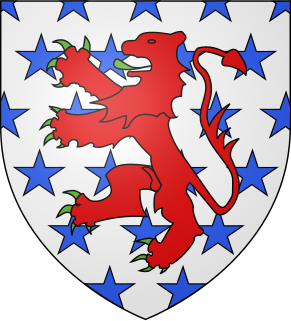
Galehaut is a very tall knight in the Arthurian legend. He is most prominent within the Lancelot-Grail prose cycle where he is a noble enemy turned an ally of King Arthur as well as an inseparable friend of Arthur's champion Lancelot. The figure of Galehaut should not be mistaken with Lancelot's son, Galahad, and some other similarly named characters.
Bagdemagus (pronounced /ˈbægdɛˌmægəs/), also known as Bademagu(s/z), Bagdemagu, Bagomedés, Baldemagu(s), Bandemagu(s), Bangdemagew, Baudemagu(s), and other variants, is a character in the Arthurian legend, usually depicted as king of the land of Gorre and a Knight of the Round Table. He originally figures in literature the father of the knight Maleagant, who abducts King Arthur's wife Queen Guinevere in several versions of a popular episode. Bagdemagus first appears in French sources, but the character may have developed out of the earlier Welsh traditions of Guinevere's abduction, an evolution suggested by the distinctively otherworldly portrayal of his realm. He is portrayed as a kinsman and ally of Arthur and a wise and virtuous king, despite the actions of his son. In later versions, his connection to Maleagant disappears altogether.
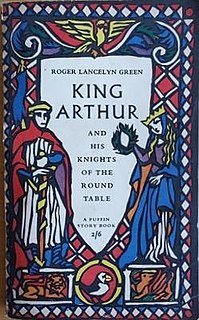
King Arthur and His Knights of the Round Table is a novel for children written by Roger Lancelyn Green. It was first published by Puffin Books in 1953 and has since been reprinted. In 2008 it was reissued in the Puffin Classics series with an introduction by David Almond, and the original illustrations by Lotte Reiniger.
















